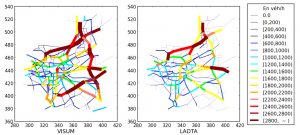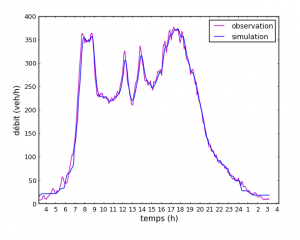Objective
In ESTIMAIR, we rely on a dynamic traffic assignment (DTA) model called LADTA. Based on a time-varying origin/destination matrix and road network (with limit speeds and road capacities), the model computes the traffic flow and speed in all roads of the network. It was compared with a static traffic assignment model, and evaluated against measurements.
Dynamic traffic assignment vs. static traffic assignment
We compared the performance of dynamics traffic assignment, using LADTA, and static traffic assignment, using VISUM, in the city Clermont-Ferrand (France). Both models can show significant differences, as illustrated by the traffic flow below, which was computed for a peak hour.
The dynamic traffic assignment allowed us to compute time-dependent traffic flow. The dynamic origin/destination matrix was computed using observations from inductive loop traffic detectors. The resulting dynamic of the spatially averaged flow is consistent with the observations, as show below.
References
More is available in this publication:
R. Chen, V. Aguiléra, V. Mallet, F. Cohn, D. Poulet, F. Brocheton. A sensitivity study of road transportation emissions at metropolitan scale. Journal of Earth Sciences and Geotechnical Engineering, vol.7, no. 1, 151-173, 2017.
For more references about LADTA, see:
V. Aguiléra, F. Leurent, Large problems of dynamic network assignment and traffic equilibrium: Computational principles and application to paris road network, Transportation Research Record, Journal of the Transportation Research Board 2132 (2009) 122–132.
F. Leurent, On network assignment and supply-demand equilibrium: An analysis framework and a simple dynamic model, in: European Transport Conference Proceedings, 2003.



